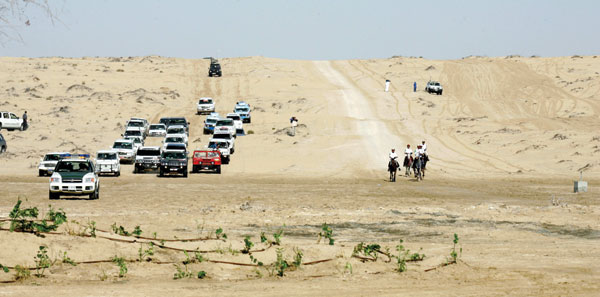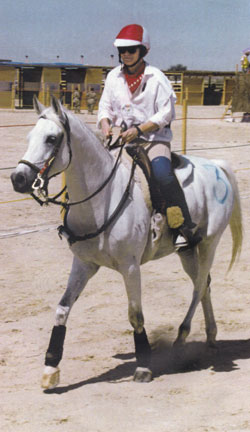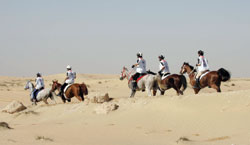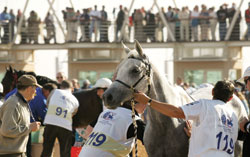Endurance Riding Royalty
 |
Support teams, judges, and emergency personnel follow the race, ready to give immediate assistance.
|
To finish is to win. That is the motto used by endurance riders, and it was never more true than when the World Equestrian Games were held in Dubai, United Arab Emirates, in 2001.
There were 276 riders from 33 countries that started the ride, but the attrition rate was so high only 38 per cent finished the 160-kilometre course.
 |
Christy exercising her horse, Tang, in preparation |
“It was very hot, 44 degrees Celsius and it was all desert,” explains Christy Janzen of Devon, Alta., one of six Canadians who rode in the event. She is a member of the Endurance Canada Hall of Fame and, to date, has ridden over 16,000 competitive kilometres.
“There were lots of sand dunes as deep as a horse’s knee and they were very treacherous because the sand was very unstable,” Janzen explains. “This makes it very hard on a horse’s ligaments. There were also lots of salt flats that were as hard as running on pavement?—also hard on a horse’s joints. You had the two extremes and both were very difficult.”
Entrants had 24 hours to complete the course, with the average finish time being about 14 hours and the average speed about eleven kilometres per hour. Janzen completed the ride in nine hours and 20 minutes.
“I was the only Canadian to finish and the Canadian ambassador was waiting at the finish line, clapping and waving flags with the rest of the Canadians.”
Janzen said the rules have changed since her 2001 ride, as the organizing committee of a World Cup event now gets to set the completion time?—?and it can be as little as 14 hours.
She said most of the horses were Arabians because with their short cannons and backs they were bred for the desert. About 80 per cent were purebreds and the rest were crosses.
There was a minimum weight requirement of 165 pounds, so light riders had weights added to their saddlebags.
It was hosted by His Highness Sheikh Mohammed bin Rashid Al Maktoum, Vice President and Prime Minister of UAE and Ruler of Dubai. “He is such an avid horseman that he paid for everything,” says Janzen.
“Because we had been invited by the Sheikh, we were treated like royalty and rode with him and his family many times. He wanted the best of the best so he paid to bring in all the horses, and built special barns so each country could quarantine their horses. It was so hot all the barns were air conditioned.”
 |
Racing the desert is not for the faint of heart;
|
Janzen said that in order to avoid contamination and the spread of any infectious horse diseases, the horses were brought over a month in advance of the event and kept separate until the day of the ride.
She said there were six check points throughout the ride and the last one was the finish line. Because they were so strict about the horses’ condition, a panel of three veterinarians checked each horse and they could disqualify one even after it crossed the finish line.
One of the things the panel watched for is a horse’s gait to see how fluid it was. This is called “way of going.”
“Another aspect the panel monitored was the heart rate in regards to a horse’s recovery time. The veterinarians also checked for amount of dehydration, soundness, and the quality of movement. Any problems and the horse was immediately disqualified,” says Janzen.
Many entrants trained their horses and themselves for as long as five years. That’s because Arabian horses grow slower than a lot of other breeds. It takes about six years for an Arabian to become full grown.
 |
Christy Janzen and her mount, Sakic |
For training, they need long, slow miles and a build-up program. You stay at each level for a while until it is normal and easy for the horse, and then you move on. All the while, you keep monitoring fitness and such things as the recovery rate to make sure what you are asking is easy for the horse to do. You want it easy because it builds confidence and faith in the rider.
“You build faith so that you can work as a team; that we can do this together,” Janzen explains.
When a rider competes at the elite level such as the World Equestrian Games, it is important that they are as fit as the horse, so many work out in the gym and jog. They also need to be trained to ride “light and balanced” so they are part of the horse and not “bouncing around all over the place.”
Needless to say, they must have good horsemanship skills to keep their horse collected and balanced at all times. A well-trained rider always remains emotionally strong and positive because if a rider feels tired, then the horse feels tired.
Another important aspect of elite endurance riding is the formation of a good pit crew, a role Janzen herself has filled. In 2004, Janzen and her son Brett were part of the pit crew that helped fellow Albertan Kelvin Godin win a Bronze medal at the Pan Am Games in Oregon, USA. Then in 2005, she returned to Dubai as a crew member for Canadian rider, Lana Halischeff.
 |
A rider’s pit crew and veterinarian checking a |
Competitors need an experienced team so that when they arrive at a check point their crew knows immediately if a horse needs a massage, his legs iced, or to be walked. If you don’t have a pit crew to do this, then the rider has to do it, or it doesn’t happen?—and the horse doesn’t get the extra attention it may need.
The horse Janzen used for her Middle East rides was named Tang. She continues to compete and now rides Sakic.
“We bred for him so I’ve had him since birth. He is named after Joe Sakic, the captain of Canada’s Gold medal-winning hockey team.”
Sakic was the leading horse for Endurance Canada this past summer and finished in third place.
Post script:
This summer, Janzen and Sakic competed in the NAETC Finals in California. The four-member team comprised of Janzen, Terre O’Brennan on Koszaar, Kathy Irvine on Nightwinds Savanah, and Yvette Vinton on DJB Boomer rode to a fourth-place finish.
For more information on endurance riding, visit www.endurancecanada.ca
Writer Milton Cust enjoyed a long career in the newspaper industry. He is now enjoying semi-retirement as a freelance writer. He makes his home in Edmonton.
“A love for horses runs in my blood. Don’t forget that horses have been bred for centuries by Arabic tribes, they were used for hunting and fighting and they symbolize our history. Horse riding is more than merely sitting on a horse’s back. It is nobility and chivalry.” ? —?His Highness Sheikh Mohammed bin Rashid Al Maktoum















